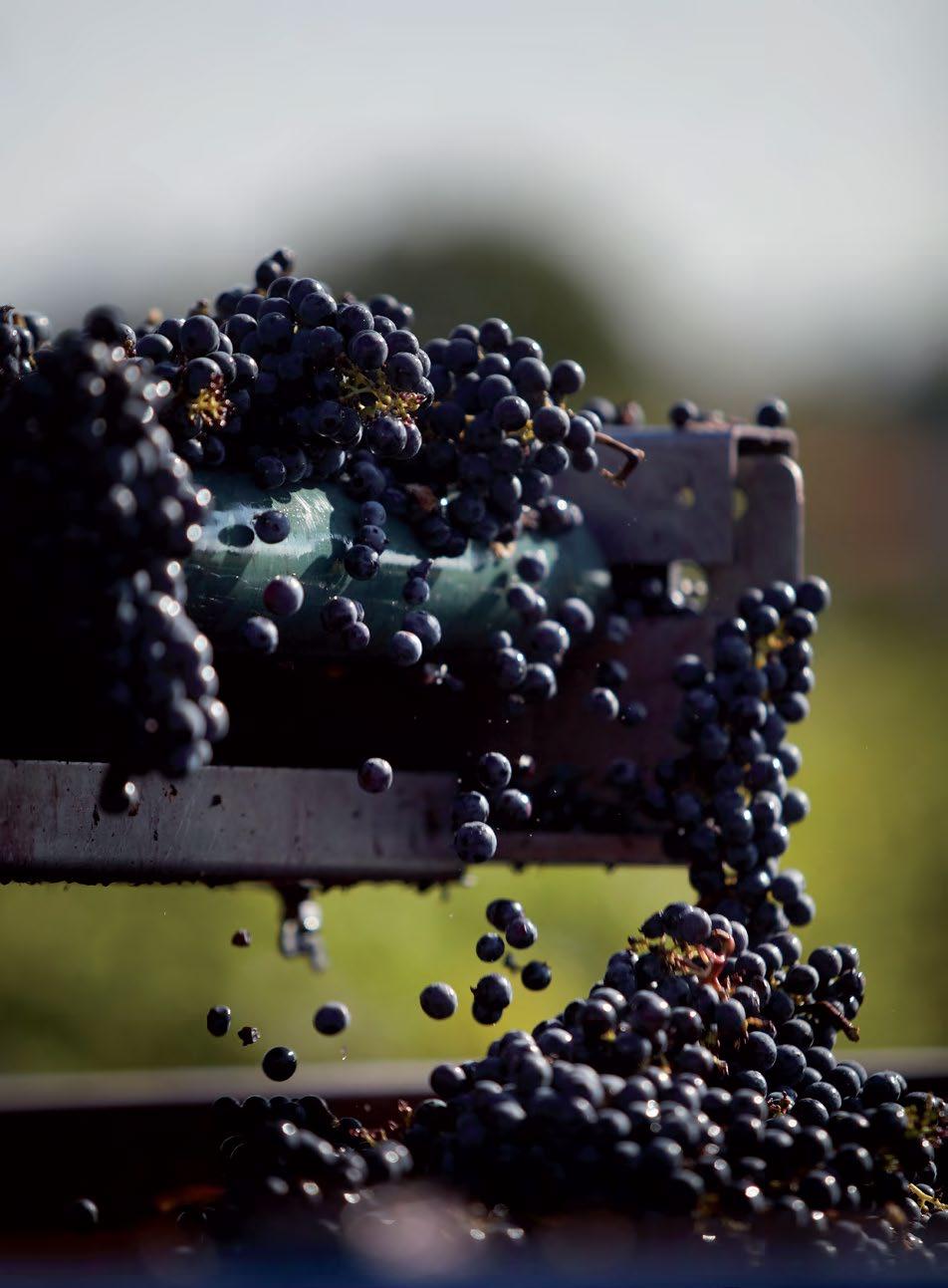Vineyards Guide
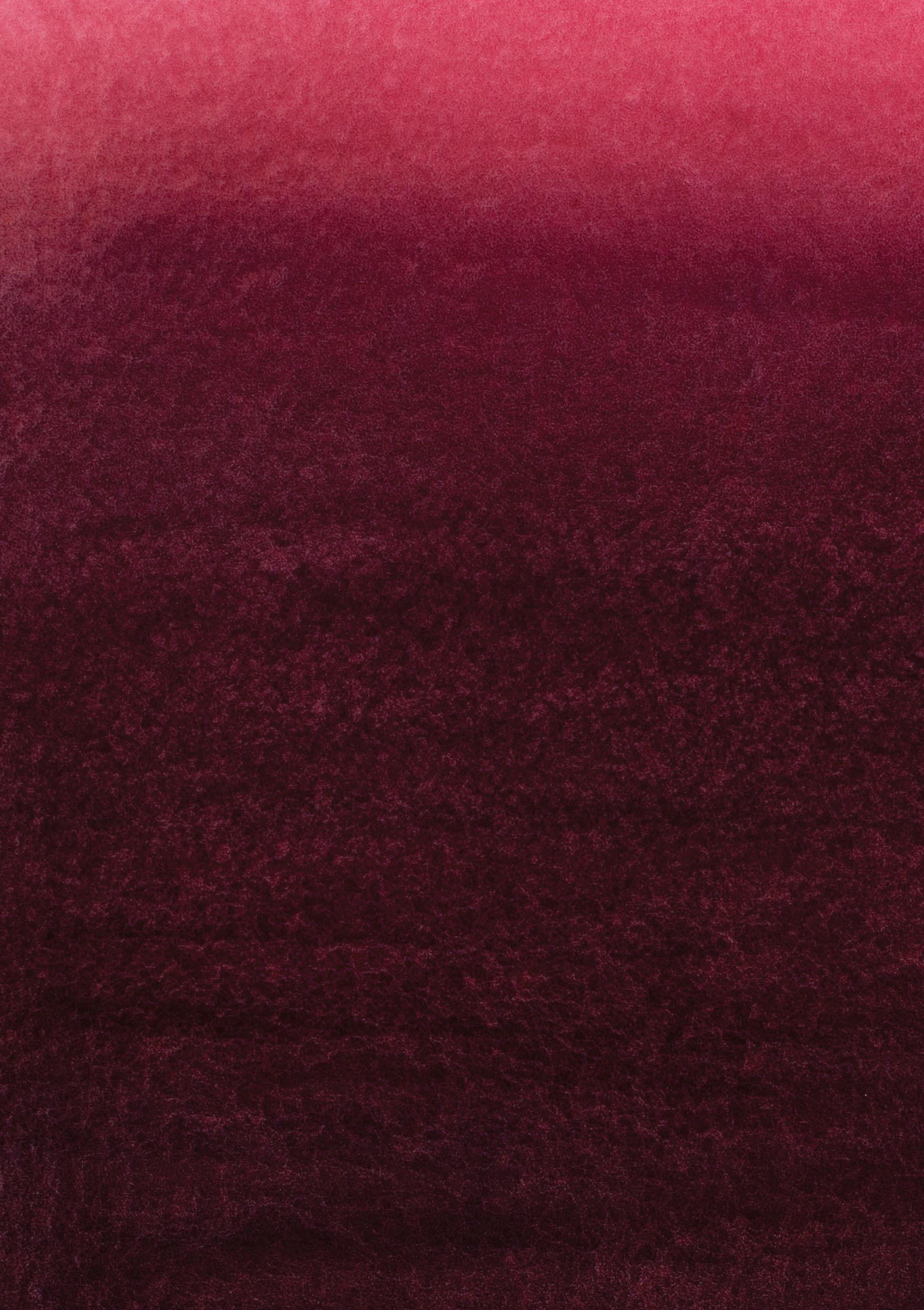
A life explored, a story bottled
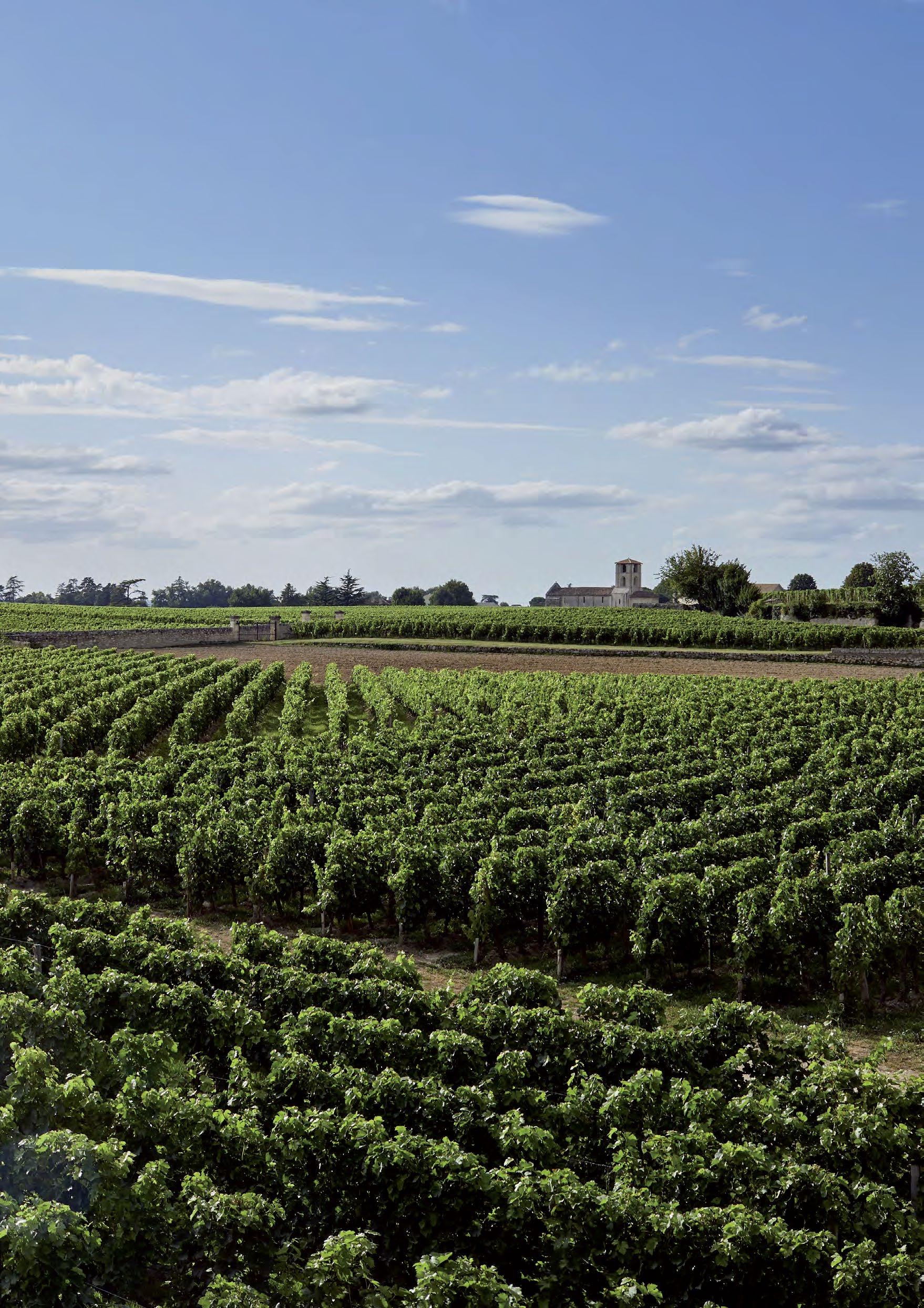


A life explored, a story bottled

This booklet summarises the characteristics of each VINIV vineyard and allows you to take notes as you discover the wines that may become a component of your blend.
With very few notable exceptions, the most complex and vibrant Bordeaux wines combine several grape varietals that unite to create a perfect balance.
Traditionally, château owners are confined to using grapes exclusively from their own property to benefit from using that property’s name and appellation. As a result , they take great care to plant the varietals that best match the soil and climate to ensure that they produce the best possible wine.
At VINIV, you have the freedom to blend across several of the most prestigious appellations from both the left and the right banks of Bordeaux to produce a wine that truly corresponds to your own personal taste. We select varietals from the vineyards where they grow best: all of our Cabernet Sauvignon parcels are in the Médoc (Margaux, Pauillac, Saint-Estèphe) and our Merlot and Cabernet Franc parcels come from Saint-Émilion and Pomerol.
Blending grapes from different appellations may be taboo to Bordeaux traditionalists. But making wine with VINIV is all about flair and daring to be different , ensuring that you have a truly unique story to tell every time you serve your wine.
We recommend that you keep this booklet throughout your winemaking journey, as your notes will guide you through the different tastings For this reason, we suggest you put your name and number here, just incase it gets left in a tasting room.
Name :
Phone Number :
As a VINIV winemaker, you must first decide on the overarching characteristics of your wine and your ageing objectives. The style of wine you intend to produce will drive your discussions and blending sessions with the VINIV winemaking team. I will help define the specific vineyards, varietals and their overall weighting in your wine.
Here are some questions to consider which will drive this decision:
- What style of Bordeaux wine do you want to produce?
- When do you intend to drink your wine – soon (3-5 years), or would you like to age it for a length of time (10-15 years) ?
- Do you have any preferred properties or appellations in Bordeaux?
We hope you enjoy your tasting.



1
1
1
3
4 .
5 . Colette


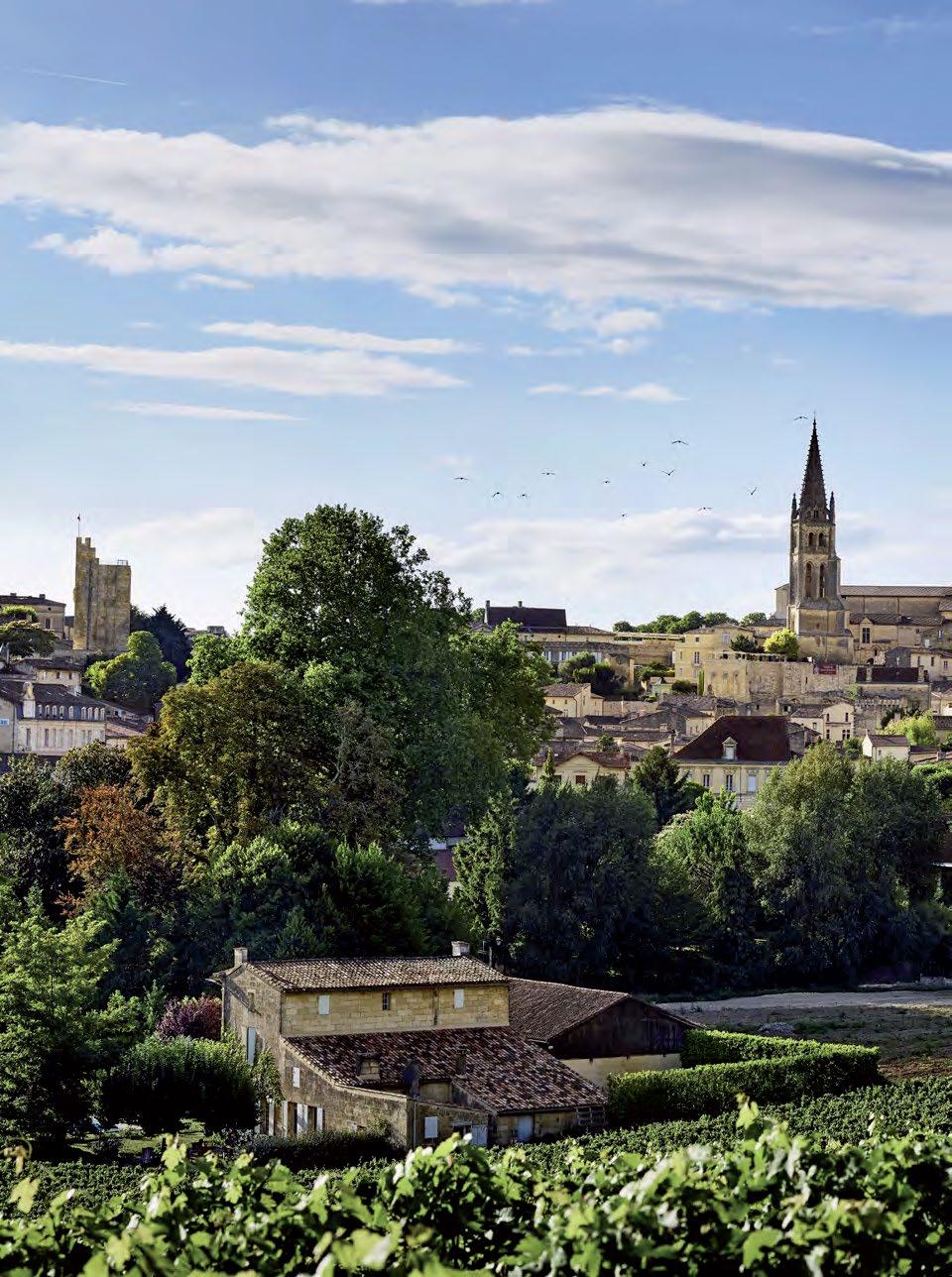
The most widely planted grape varietal in Bordeaux, Merlot is also the most adaptable varietal in the region. It is at home on many different soil types, but finds its greatest expression on the clay and limestone, gravel or sandy soils of Bordeaux’s Right Bank (Saint-Émilion and Pomerol). Merlot is precocious at budburst , grows easily and ripens faster than Cabernet Sauvignon and Cabernet Franc, which make it particularly suitable to the cooler soils of the Right Bank.
As a stand-alone varietal, Merlot has a lighter, smoother tannin structure than its Cabernet counterparts. It provides fruit , volume, alcoholic richness and accessibility to any wine blend. Vineyards located in the higher sections of Saint-Émilion are capable of producing wines with impressively persistent tannins, whereas the wines from Pomerol’s gravel and clay plateau provide a creamy richness along with tannic intensity.
Merlot produces colourful wines that tend to evolve faster than Cabernet Sauvignon. These wines develop aromas of ripe fruit (cassis, strawberry) and can evolve towards enjoyable hints of jam and leather with longer ageing.
VINIV only selects Merlot vineyards from Bordeaux’s Right Bank, where this varietal reaches its greatest expression.

1
Petit Jean Saint-Émilion Fruit-driven wine with soft, plump, tannins
2 . Le Plateau Fronsac A balance between fruit and structure, without ever overpowering a blend.
3 La Pyramide Saint-Émilion An intense and powerful Merlot Tension combined with elegance.
4 . Les Terrasses Saint-Émilion Full-bodied wine which maintains incredible freshness
5 . Colette Pomerol Expressive, creamy, velvety Pomerol Merlot
S A I N T É MI L I O N GR A N D C R U
SO I L : S A N D Y CL AY O V E R GR AV E L
The Merlot grapes from the lower plain in Saint Emilion have the advantage of being very approachable in their youth, with fresh crunchy fruit , yet the fleshy tannins mean that it is perfectly suited to aging. A beautiful fruit-driven wine with soft , plump, tannins.
Situated on a gravel outcrop on the plain in the commune of Saint-Sulpice de Faleyrens in the South of the appellat ion, this small plot of vines was planted in 1970 Although the subsoil is gravel there is a significant amount of stone on the sur face, which reflects the heat of the day and radiates the warmth in the evening, ensuring ripeness.

TYPE OF SOIL
ALTITUDE
VINEYARD SUN EXPOSURE
SLOP STEEPNESS
VINES DENSITY
VINES AGE (AVG)
FARMING APPROACH
WINEMAKING APPROACH
Clayey sand over gravel
AGEING APPROACH
TA S T IN G N O T E S
Slightly south-facing
Gentle
5,500 vines/ha
Planted in 1970
Sustainable farming
Temperature-controlled stainless-steel tanks. Cold pre-fermentation maceration, inoculated at 18°C. Pump-overs without air: intense at the start, progressively gentler and less frequent at the end of fermentation. Post-fermentation maceration at 26-28°C.
80% new French oak barrels, 20% one-year-old barrels. Ageing for 18 months. 5m
F R ON S A C
SO I L : C L AY O V E R L I M E S T O N E
W I N E P R OF I L E
Le P l a t eau i s i d eal fo r those seeking com pl exity w ithout overp owering their ove rall win e bl end. T he w ine p resents a ba l ance bet ween an inten s e , ripe t annic structu re and th e
c l a ss ical, r ich fruit cha racteris t ics of this varietal. This is an i deal v in eya rd for thos e
s eeki n g to c reate an imp ress ive wine that begins to reveal i t self a bit sooner than it s S ai n t-Émilion counterpa r t s
S I T E DE S CRI P T IO N
This vineyard is located on the ridge of the picturesque amphitheatre of Fronsac, where the best properties of the appellation are located. This location benefits from ample sunshine and heat retention and is located in a sector where the friable limestone can be found just underneath a base layer of clay

TYPE OF SOIL
ALTITUDE
VINEYARD SUN EXPOSURE
SLOP STEEPNESS
VINES DENSITY
VINES AGE (AVG)
FARMING APPROACH
WINEMAKING APPROACH
AGEING APPROACH
TA S T IN G N O T E S
Starfish limestone
70m
South, in a natural amphitheater
None
6,000 vines/ha
19 years
Certified organic with a biodynamic approach in the vineyards. Organic fertilizers. Mechanical weeding. Preparations 500 (horn manure) and 501 (horn silica) to improve soil structure and vine vitality. Follow the lunar calendar.
Gravity-fed winemaking. Concrete vats. 28-day maceration with moderate extraction. MLF in barrels or large casks.
10hL amphoras, 20hL large casks, 225L Bordeaux barrels. 30-40% new barrels. Light to medium toast. French and Austrian oak.
This Merlot is characterised by the pedigree of its ‘terroir’, producing an intense, silky yet powerful wine. The fruit and the tannins are very expressive and emphasise strength and tension over pure elegance, with a slight hint of licorice. What remains uncompromised is the overall freshness of the wine.
La Pyramide lies just East of Saint-Émilion on the top of the appellat ion’s southern ridge in an area dominated by well-known classified growths. The vines are planted directly on the limestone bedrock (an ancient quarry is located right underneath) with very lit tle clay act ing as a topsoil buf fer. As a result , the vineyard is constantly in search of water, ensuring great concentrat ion
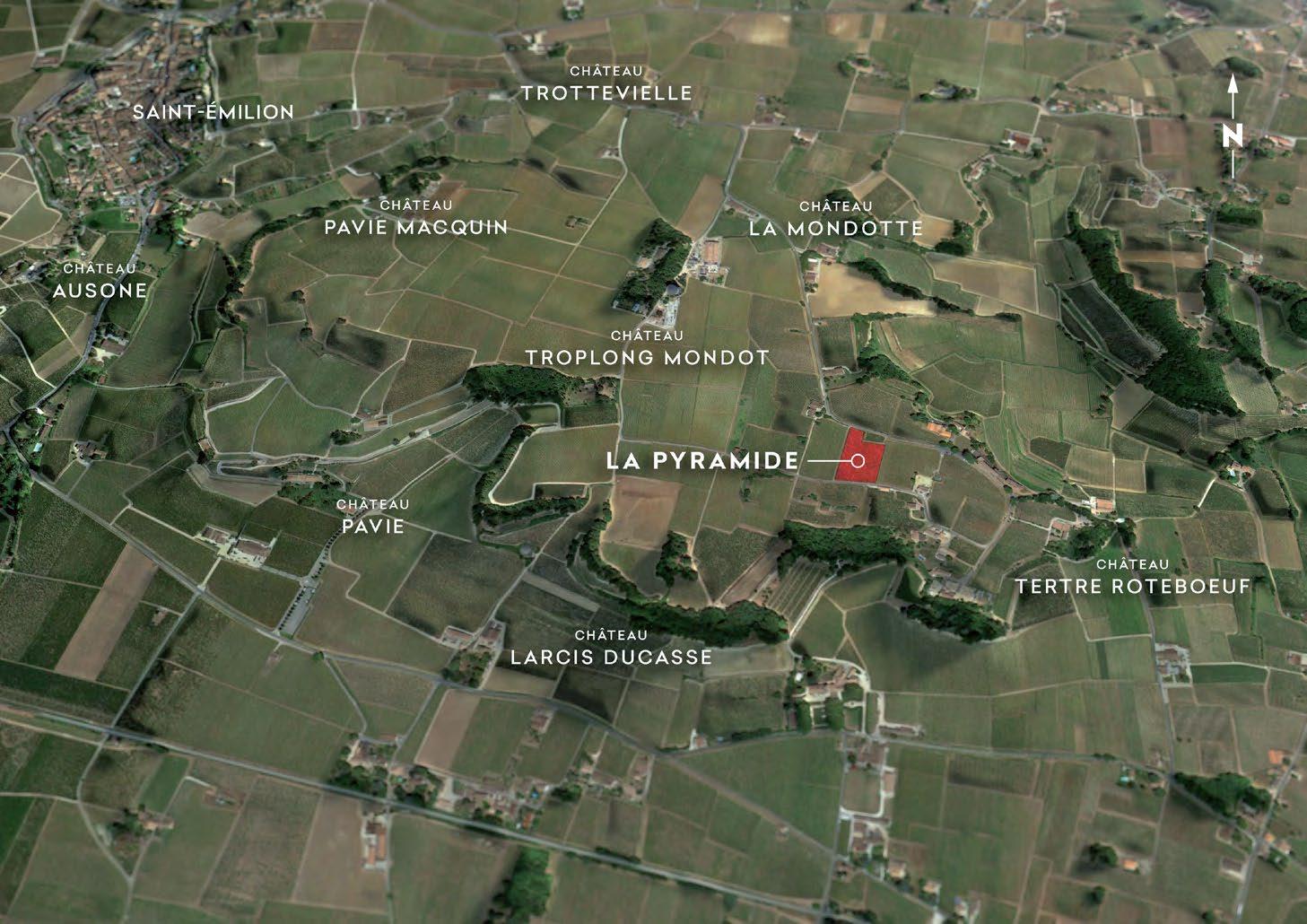
TYPE OF SOIL
ALTITUDE
VINEYARD SUN EXPOSURE
SLOP STEEPNESS
VINES DENSITY
VINES AGE (AVG)
FARMING APPROACH
WINEMAKING APPROACH
AGEING APPROACH
TA S T IN G N O T E S
Clay-limestone on starfish limestone and faluns
100 m
South, southeast, plateau
10%
6,600 vines/ha
45 years
Precision viticulture, nothing is done systematically. A specific study of wild flora guides the organic amendments. Soil pits are dug to visualize soil life and observe root development.
Extractions are gentle ranging from 2 to 6 weeks. Malolactic fermentation occurs either on the skins or after pressing.
Depending on the vintage, aging lasts between 12 to 20 months, after which the wines are refined in tanks.
This Merlot produces a finely-tuned and elegant wine with intense colour, enticing spiciness on the nose and rich dark fruit on the palate. Les Terrasses combines elegance, finesse, volume and tension, largely due to the deeper clay substrate on which the vines are planted.
Just East of Saint-Émilion, beyond the water tower and adjoining property of Troplong Mondot , sits a beautiful, almost entirely enclosed terraced recess The vineyards planted in this sector benefit from greater exposure to clay before hitting any bedrock. A natural microclimate is formed as well, creating an area less susceptible to winds and more likely to retain heat during the growing season.
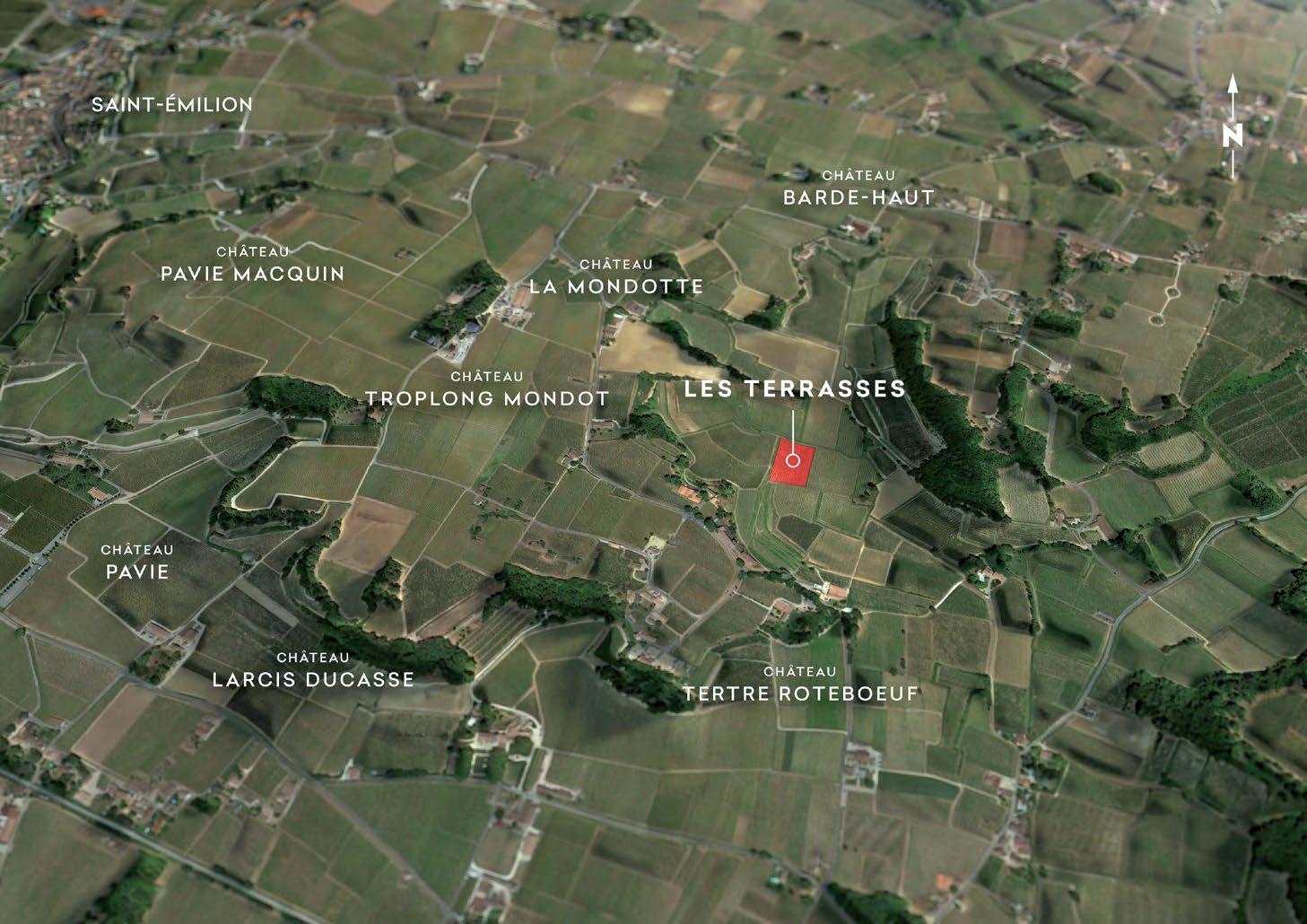
TYPE OF SOIL
ALTITUDE
VINEYARD SUN EXPOSURE
SLOP STEEPNESS
VINES DENSITY
VINES AGE (AVG)
FARMING APPROACH
WINEMAKING APPROACH
AGEING APPROACH
TA S T IN G N O T E S
55 to 80 m
Clay-limestone, Fronsadais molasse, brown clay, tuffeau (chalk), marl, and blue clay East
Terraces with no slope
6,600 vines/ha
35 years
Precision viticulture, nothing is done systematically. A specific study of wild flora guides the organic amendments. Soil pits are dug to visualize soil life and observe root development.
Extractions are gentle ranging from 2 to 6 weeks. Malolactic fermentation occurs either on the skins or after pressing.
Depending on the vintage, aging lasts between 12 to 20 months, after which the wines are refined in tanks.
P OM E R O L
SO I L : ‘GUN Z ’ GR AV E L O V E R C L AY
W I N E P R OF I L E
Colette is textbook Pomerol. A soft , velvety and discretely complex Merlot , with deliciously silky tannins that are less pronounced that its “top-of-the-hill” Saint Emilion counterparts.
This vineyard sits in the southern sector Pomerol’s famed plateau of ’Gunz’ gravel and clay soil. These 40 year-old Merlot vines are located in the sector that separates Château Beauregard from the Figeac sector of Saint-Émilion.

TYPE OF SOIL
ALTITUDE
VINEYARD SUN EXPOSURE
SLOP STEEPNESS
VINES DENSITY
VINES AGE (AVG)
FARMING APPROACH
WINEMAKING APPROACH
AGEING APPROACH
TA S T IN G N O T E S
Gravelly-sandy soil with an iron oxide and clay subsoil
South
6 000 vines/ha
35 years
Sustainable farming (HVE3 version 4), they use biocontrol methods and make their own compost to regenerate the soils.
Vinification in temperature-controlled tanks with daily pump-overs. After the two fermentations are complete, they move to barrel aging.
Depending on the wine's structure, they proceed with barrel aging for 12 to 18 months with a mix of new and older oak barrels. 23m

Cabernet Franc is the third most planted red grape varietal in Bordeaux, after Merlot and Cabernet Sauvignon. It is particularly adaptable to cooler climates and soil – such as those found in Saint-Émilion and surrounding areas – because it matures faster than Cabernet Sauvignon and tends to better resist bad weather in the late season just before harvest .
Cabernet Franc produces a medium-bodied wine with more pronounced fruit than Cabernet Sauvignon in the younger years. This varietal also offers impressive aromas to any wine blend. Cabernet Franc planted at higher elevation (as in Saint-Émilion) can also denote hints of spice and dark pepper, providing an additional layer of complexity This varietal is most famously combined with Merlot in ‘Right Bank’ blends to provide freshness and structure. In many Médoc-style blends, it can be found in proportions of anywhere from 5% to 40%.
At VINIV, some of our most impressive wines have been those produced by members who have chosen Cabernet Franc as their dominant blend component
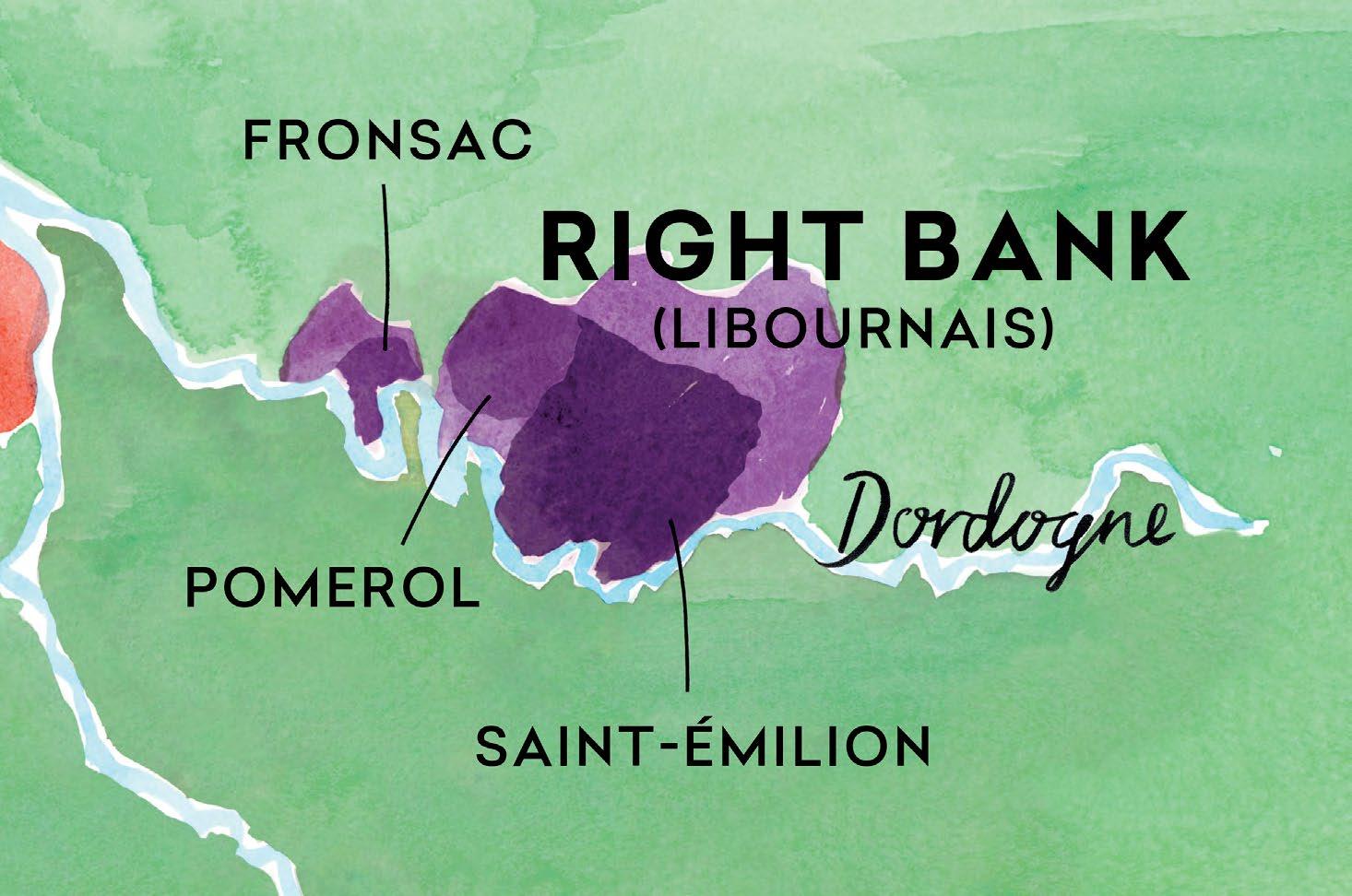
6 . Pinson Saint-Émilion Aromatic purity and mineral tension
7 . La Carrière Saint-Émilion A hilltop Cabernet Franc with freshness, vibrancy and a hint of spice.
A wine that combines the aromatic purity and mineral tension that is characteristic of the Cabernet Franc variety. Traditionally considered a blending element on the Right Bank where it is solicited for its elegance and refreshing finish, Cabernet Franc is becoming increasingly appreciated for its intrinsic qualities and, as a result, features more and more prominently in blends
Two small plots of vines located near Vignonet to the West of Château Teyssier, lying on the Saint Émilion plain. The vineyards, planted in 1957 and 1964, lie on deep silica soils over clay, a combination that is perfectly suited to the Cabernet Franc grape. The age of these vines is such that they naturally produce a lower, richer crop. This is complemented by green harvesting, which guarantees a depth of fruit essential in the profile of this variety.
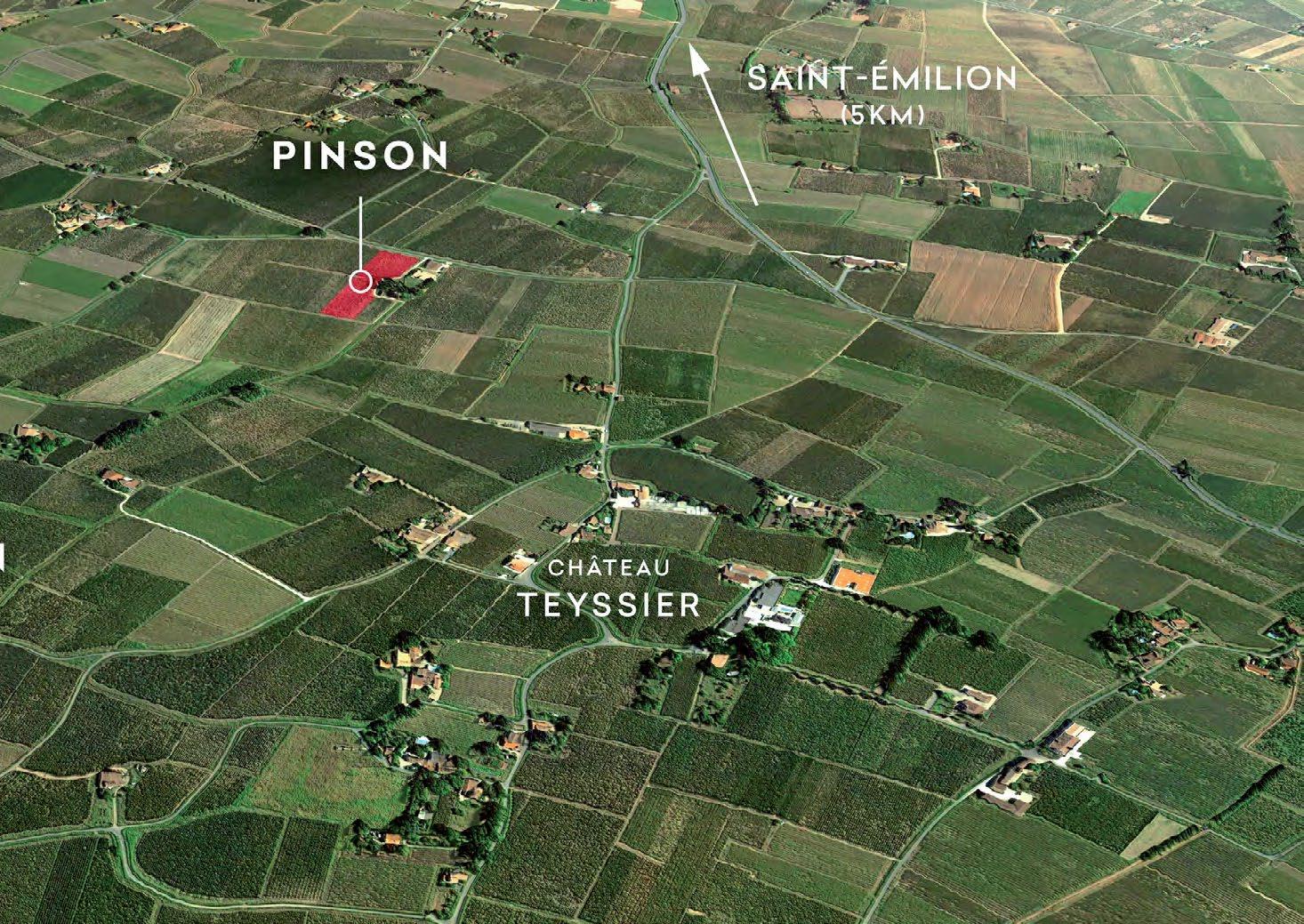
TECHNICAL DATA
TYPE OF SOIL
ALTITUDE
VINEYARD SUN EXPOSURE
SLOP STEEPNESS
VINES DENSITY
VINES AGE (AVG)
FARMING APPROACH
WINEMAKING APPROACH
Sandy clay over clay with iron deposits, between 40 and 80 cm deep
AGEING APPROACH
TA S T IN G N O T E S
Slightly south-facing
Gentle
5,600 vines/ha
Planted in 1957 and 1964
Sustainable farming
Temperature-controlled stainless-steel tanks. Cold pre-fermentation maceration, inoculated at 18°C. Pump-overs without air: intense at the start, progressively gentler and less frequent at the end of fermentation. Post-fermentation maceration at 26-28°C.
80% new French oak barrels, 20% one-year-old barrels. Ageing for 18 months. 7.5m
This vineyard produces a wine that is characterised by complex notes of spice and rich ripe fruit . The vineyard’s geographic situation ensures both tannic intensity and a balance between volume, tension and freshness. More rounded and complex than Le Barrail, La Carrière has a delicate hint of toast that underlines the fruit aromas.
This south-facing vineyard sits near the top of the ridge just southeast of Saint-Émilion, right within the triangle that separates Château Pavie from Larcis Ducasse and Troplong Mondot The 40 year-old vines are planted directly on the bedrock. Very little clay separates the vine from the limestone, ensuring both concentration and intensity in the resulting wine.
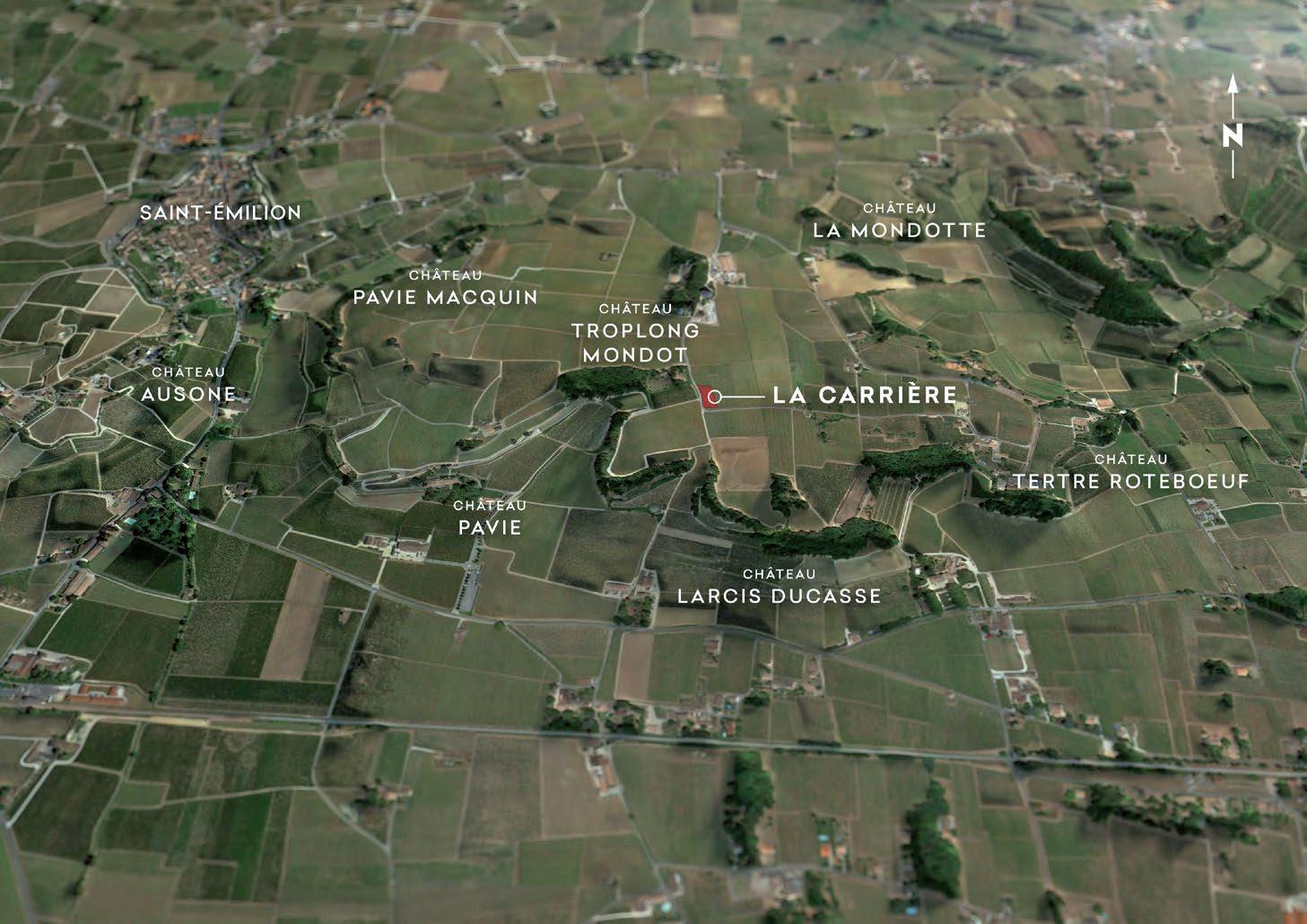
TYPE OF SOIL
ALTITUDE
VINEYARD SUN EXPOSURE
SLOP STEEPNESS
VINES DENSITY
VINES AGE (AVG)
FARMING APPROACH
WINEMAKING APPROACH
AGEING APPROACH
TA S T IN G N O T E S
100m
Clay-limestone on starfish limestone Southeast Plateau
6,600 vines/ha
38 years
Precision viticulture, nothing is done systematically. A specific study of wild flora guides the organic amendments. Soil pits are dug to visualize soil life and observe root development.
Extractions are gentle ranging from 2 to 6 weeks. Malolactic fermentation occurs either on the skins or after pressing.
Depending on the vintage, aging lasts between 12 to 20 months, after which the wines are refined in tanks.

VA R I E TAL D E S C R I P T I O N
This varietal enjoys warm soils with little clay and finds its greatest expression in the gravel and sand sectors of the Médoc and Graves.
Cabernet Sauvignon’s clusters are smaller and tighter than those of Merlot . As a result , the concentration and surface area of the seeds are more important . It is a later-maturing varietal, typically harvested 10 to 15 days later than Merlot . It is also known for producing lower yields than Merlot and is relatively lower in sugar, thus has lower alcohol potential.
Cabernet Sauvignon is most recognised for its exceptional structure, ageing potential and ability to reveal the expression of its ‘terroir’ This varietal dominates the blend of virtually all of the Médoc 1855 Classified Growths, though it is rarely used on Bordeaux’s Right Bank because of its fragile nature and later ripening. When young, these wines are very tannic with a rich color and red/black fruit characteristics that evoke cassis, spice, pepper, chocolate and mint . As these wines age, they reveal all of the elegance and finesse of this exceptional grape varietal.
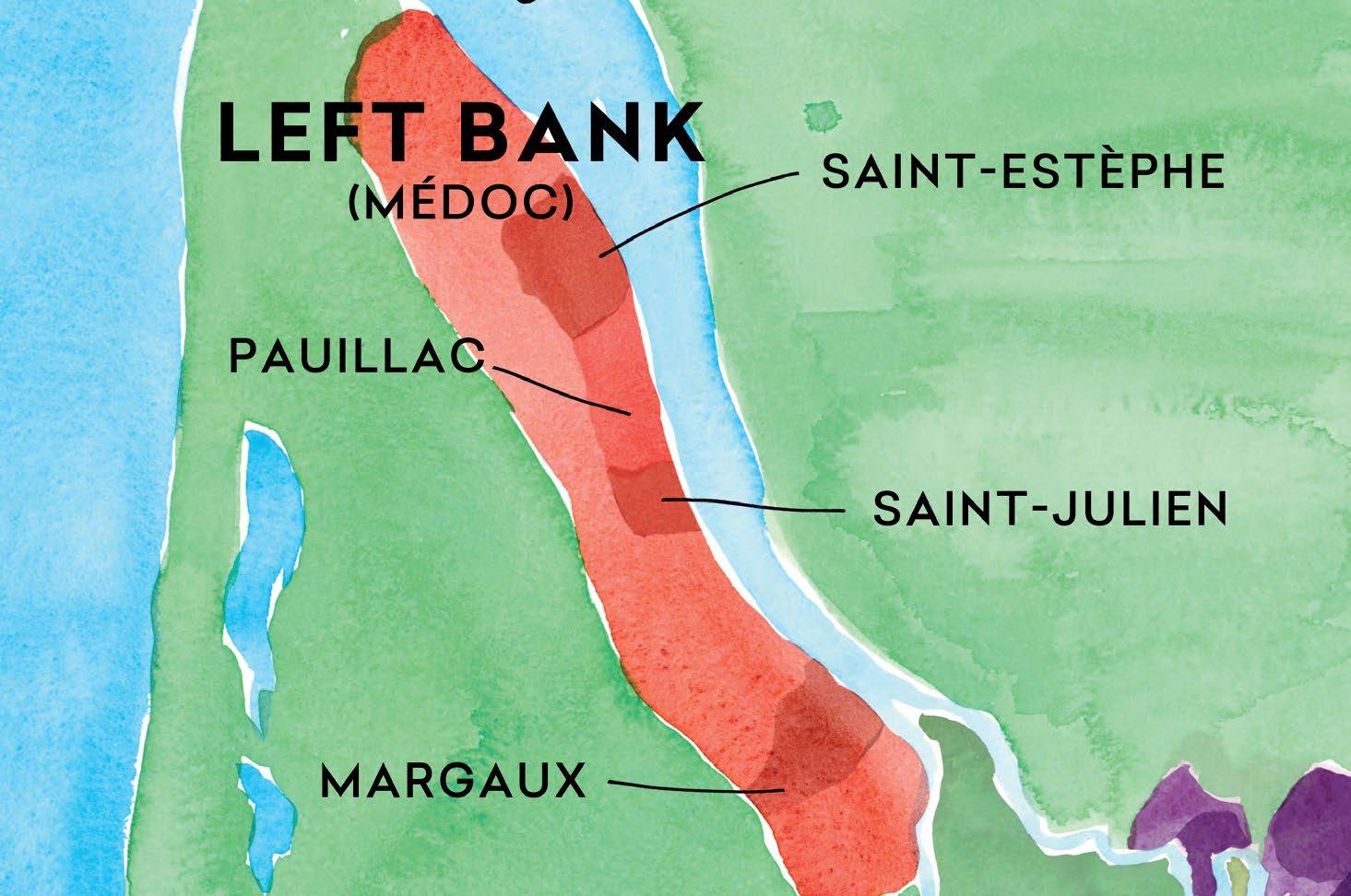
8 . Le Marquis Margaux
9 . Le Moulin Saint-Julien
1 0 L’Espérance Pauillac
1 1 . L’Enclos Pauillac
1 2 . Demi-Lune Saint-Estèphe
An elegant yet powerful wine, with fine-grained tannins and rich, dark fruit
Silky, smooth but firm tannins and a delicate structure make this a great blending component, in a style that is typical of the Saint-Julien appellation.
All the power and structure of a Pauillac Cabernet Sauvignon with a slightly more delicate edge.
A denser more powerful Pauillac Cabernet Sauvignon, thanks to its warmer soil and unique microclimate.
Very expressive fruit and fine grained tannins define this wine, which sits on ideal Saint-Estèphe terroir.
M A R G A U X
SO I L : D EE P MA R G A U X GR AV E L
Le Marquis combines power and elegance, with smooth, finely-grained tannins and powerful dark fruit characteristics. As a blend component , this wine offers density, structure and richness without ever compromising the typicity and complexity of the appellation.
Located in the heart of the appellation, on one of the most sought-after plots between Château Lascombes and Château Rauzan-Ségla. Deep Margaux gravels give Le Marquis its distinct character.

TYPE OF SOIL
ALTITUDE
VINEYARD SUN EXPOSURE
SLOP STEEPNESS
VINES DENSITY
VINES AGE (AVG)
FARMING APPROACH
WINEMAKING APPROACH
AGEING APPROACH
TA S T IN G N O T E S
28 years
Sustainable farming. HVE Level 4. Environmental Management System (SME). Terra Vitis and Bee Friendly certified.
Maceration for 4 weeks. Gentle extraction: punch-downs during the first third, pump-overs during the second third, and light sprinkling during the final third.
14 months in barrels: 50% new oak and 50% one-wine barrels. 16m
W I N E P R OF I L E
Le Moulin combines elegance and finesse in a style that is typical of the Saint-Julien appellation. Silky, smooth but firm tannins and a delicate structure make this a great blending component and a welcome new addition to the range.
S I T E DE S CRI P T IO N
Château Moulin de la Rose is often called the “Lilliput of Saint-Julien”, as its vineyards nestle between those belonging to the larger properties of Château Gruaud-Larose, Lagrange and Ducru-Beaucaillou. Planted at a density of 9000 vines/hectare in 1986, this parcel lies on a slightly raised plateau in the highly sought-after sector of Beychevelle. Deep Garonne gravel, combined with clay and sand, ensures exceptional drainage and maturity.

TYPE OF SOIL
ALTITUDE
VINEYARD SUN EXPOSURE
SLOP STEEPNESS
VINES DENSITY
VINES AGE (AVG)
FARMING APPROACH
WINEMAKING APPROACH
AGEING APPROACH
TA S T IN G N O T E S
Sustainable farming; HVE Level 4 (High Environmental Value certification).
3-week maceration in temperature-controlled stainless-steel tanks.
Aged 20 months in barrels, one-third of which are new oak barrels. 18m
The grapes from this vineyard add an extra touch of elegance and finesse to the typical power and structure of a Cabernet Sauvignon from Pauillac. The aromatic palette is rich and vibrant, with notes that range from dark fruits to violet and cedar. L’Espérance is the ideal choice for winemakers seeking a fresh Pauillac Cabernet Sauvignon with a tannic structure that is both powerful and silky, offering perfect balance.
Located in the southern sector of the Pauillac appellation, the soil in this sector is composed largely of gravel and sand, with a low level of clay (5–10%). This terroir confers a level of finesse and elegance to the Cabernet Sauvignon, reminiscent of Saint-Julien, while remaining beautifully structured.

TYPE OF SOIL
ALTITUDE
VINEYARD SUN EXPOSURE
SLOP STEEPNESS
VINES DENSITY
VINES AGE (AVG)
FARMING APPROACH
Gravel, sand and brown clay
WINEMAKING APPROACH
AGEING APPROACH
TA S T IN G N O T E S
North/South (rows planted East/West)
None
10,000 vines/ha (1m between vines and 1m between the row)
61 years
No herbicides. Use of green manure (winter cover crops). No insecticides. Manual pruning using Médoc-style double Guyot (preserving sap flow).
Gentle extraction methods (pump-overs and rack-and-return), maceration for about 21 days. MLF: 1/3 in barrels, 2/3 in tanks.
Aged for 16 months with 60% new oakRacked every 3 months. 20m
SO I L : G R AV E L A N D D EE P C L AY
L’Enclos typically produces powerful wines of great concentration, volume and density, with tight , fine-grain tannins and opulent fruit that are consistently synonymous with this property. This wine is an ideal blend component for winemakers seeking all of the character of a long-aging and powerful Pauillac Cabernet Sauvignon with a very long finish.
Located within the ‘enclosure’ of the Cazes family’s Relais & Châteaux hotel, Cordeillan-Bages, the soil consists of gravel, sand and a higher concentration of clay (15%) than our other Pauillac vineyard, Grande Catélie. Surrounded by tall bushes, this vineyard has a warm microclimate that pushes grape maturity a few days ahead of other vineyards in the sector

TYPE OF SOIL
ALTITUDE
VINEYARD SUN EXPOSURE
SLOP STEEPNESS
VINES DENSITY
VINES AGE (AVG)
FARMING APPROACH
WINEMAKING APPROACH
AGEING APPROACH
TA S T IN G N O T E S
Brown gravelly soils with a subsoil of sandy-clay gravels
14m
East/West (rows planted North/South)
None
8,500 vines/ha (1.15m between vines and 1m between the row)
37 years
HVE Level 3 certification since 2018. Organic viticulture principles (not certified). Full soil management. Sexual confusion techniques to control grapevine moths. No use of CMR products. Double Guyot Médoc pruning. Manual vineyard work.
Gravity-fed handling. Pump-overs and rack-and-return. Maceration for about 21 days. MLF: 1/3 in barrels, 2/3 in tanks.
15 months of aging with 30% new oak. Racking every 3 months.
W
These vines produce a Cabernet Sauvignon with significant power and structure, reaffirmed by ripe and smooth tannins that require a few years of aging to allow them to open up beautifully. Demi-Lune is characterised by notes of ripe red fruit, spice and a deliciously long finish.
S
This vineyard is located just off the road known as the ‘Route des Châteaux’, on one of the highest points of Saint-Estèphe. Its soil consists of 3-4 metres of gravel before reaching a clay substrate and the limestone bedrock.

TYPE OF SOIL
ALTITUDE
VINEYARD SUN EXPOSURE
SLOP STEEPNESS
VINES DENSITY
VINES AGE (AVG)
FARMING APPROACH
Brown gravelly soils with a subsoil of sandy-clay gravels
20m
North/South (rows planted East/West)
None
8,500 vines/ha (1.15m between vines, 1m within the row)
WINEMAKING APPROACH
AGEING APPROACH
TA S T IN G N O T E S
HVE Level 3 certification since 2018. Full soil management. Sexual confusion techniques to control grapevine moths. No use of CMR products. Double Guyot Médoc pruning. Manual vineyard work.
Pump-overs and rack-and-return. Maceration for about 21 days. MLF: 1/3 in barrels, 2/3 in tanks.
15-16 months of aging with 30% new oak. Racking every 3 months.
